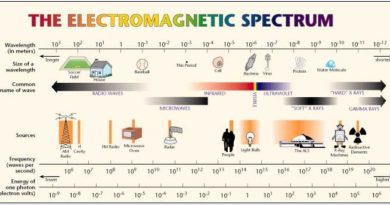Antenna Basic Principles
Antenna basic principles
An antenna can be a length of wire, a metal rod, or a piece of tubing. Many different sizes and shapes are used. The length of the conductor is dependent on the frequency of operation. Antennas radiate most effectively when their length is directly related to the wavelength of the transmitted signal. Most antennas have a length that is some fraction of a wavelength. ½, ¼ wavelength antennas are most common.
In wireless communication, an RF signal is generated by a transmitter is sent into free-space (air or atmosphere) and finally picked up by a receiver. Transmitter generates RF signal.
In radio communication systems, transmitters are connected to receivers through transmission lines, antennas and free space. A transmission line couples’ energy from a transmitter to an antenna or from an antenna to a receiver. EM waves are coupled from transmitting to receiving antennas through free-space in a manner similar to the way energy is coupled from the primary to secondary of a transformer. So, Transmission lines in communication carry telephone signals, computer data (in LANs), and TV signals (cable TV systems). They carry signals from a transmitter to an antenna and vice versa and note that transmission lines are critical links in any communication system.
Remember that transmission lines are more than pieces of wire or cable. Their electrical characteristics are critical and must be matched to the equipment for successful communication to take place. With antennas, the degree of coupling is much lower than with a transformer, and an EM wave is involved rather than just a magnetic wave.
- Antennas are used to interface transmission lines to atmosphere, the atmosphere to transmission lines or both.
- An antenna couple’s energy from a transmission line to the atmosphere and energy received from atmosphere to a transmission line
Radiation principle
Note that an important criterion for radiation is that the length of the conductor be approximately one-half or one-quarter wavelength of the AC signal. A very little radiation of EM field occurs if antenna wires are less than l/2 or l/4 wavelength. As frequency is increased, wavelength decreases. Note that wavelength (l) should be within the range of practical conductors and wires. (1 MHz to 1000 GHz).
Example: f = 60 Hz sine wave signal
l = v/f = 3x 108/60 = 5000000 metres = 5000 Kilo meters (not practical)
It is within this range that long distance radiation occurs. For example, a 300 MHz UHF signal has a wavelength of 1 meter a very practical length.
How much energy is radiated is the arrangement of the conductors carrying the signal. If they are in the form of a cable such as a transmission line with a generator at one end and a load at the other end, a very little radiation occurs at any frequency.
Size or collection of antennas
Big antenna can detect faint signals much better than small antennas. A big antenna collects lot of EM waves just like a big bucket collects a lot of rain. First antenna array operated in the kHz range. Today, array can operate at virtually any frequencies. Antenna arrays are extremely popular for use in RADARS in the microwave region.
Antenna is a structure which is associated with radio wave. The job of this structure is to either radiate or receive radio waves. One side of the antenna there is a source, source which is giving signal to the antenna and this antenna releasing signal to the free space. That means the other side free space is sitting.
Antenna is getting signal from the signal source and that is from the device and releasing signal to the free space. So, getting the signal from the device, the antenna has to behave like a device. It has to match the device, so that the maximum power transfer theorem says: maximum power or signal can be delivered to the antenna.
Similarly, after receiving this signal, antenna is trying to release it to the free space. Objective is that the maximum signal is to be released to free space so that it reaches the destination. So, the other side of the antenna it is behaving like a free space matching with free space and trying to deliver maximum signal to the free space. So, the antenna is a device sitting between a guide and unguided (or free space) systems.
